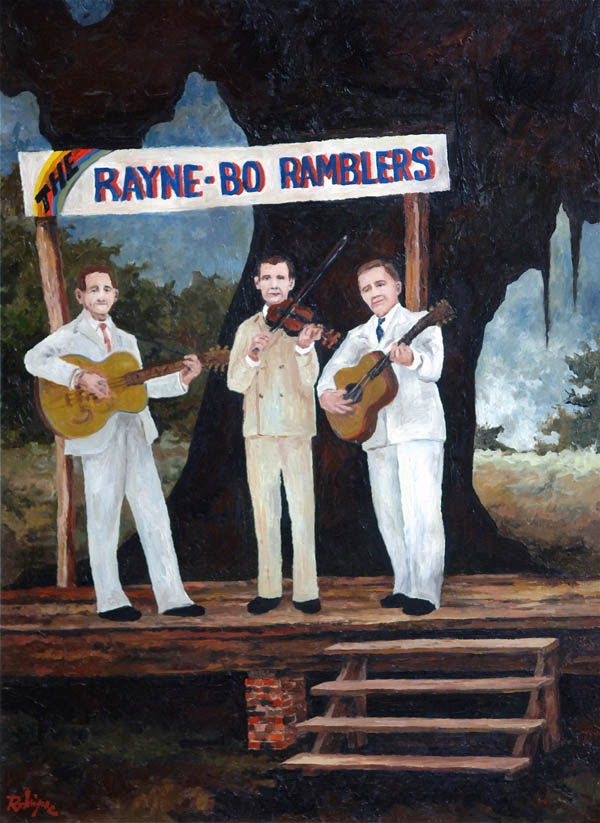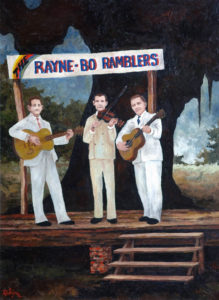Country Music
Country music in Louisiana grew out of folk traditions of white rural southerners and includes rockabilly and Cajun music as subgenres.

George Rodrigue
A color reproduction of a 1984 painting of the Rayne-bo Ramblers by Louisiana artist George Rodrigue.
Country music is a form of commercial music rooted in the folk traditions of white, rural, and small-town southerners. Country music is stylistically diverse and includes such subgenres as old-time, bluegrass, Western Swing, honky-tonk, rockabilly, and the Nashville Sound. Basic instrumentation of country music includes fiddle, guitar, steel guitar, bass fiddle, and mandolins. Louisiana country music exhibits all of these styles and is home to Cajun music, an important subset of country music. Louisianans have contributed much to the development of country music, and several major innovators and stars have called the state home.
Country music grew primarily out of the songs, ballads, dance, and fiddle tunes of the Anglo-Celtic settlers of the South. Other styles influenced the genre, including African American styles like blues and jazz. Fiddlers and string bands dominated the early sound of country music.
Historians generally agree that Texas fiddlers Eck Robertson and Henry Gilliland made the first country music recording in 1922. The first known recording by a Louisiana country music artist was a 1925 custom recording by John W. Daniel, which received little distribution. Hiter Colvin, a fiddler from Dubach, made several stunning recordings in 1929 demonstrating the driving sound that was demanded in the north Louisiana oil field camps. The Taylor-Griggs Louisiana Melody Makers were the only stringband from the state to record during the 1920s. In southern Louisiana, Cajun music both influenced and was influenced by country styles.
Louisiana country music found its greatest early stage on KWKH, a Shreveport radio station owned by W. K. Henderson. He actively promoted the careers of the Pelican Wildcats string band and a young singer named Jimmie Davis. The later started his professional career on KWKH in 1928 and soon became a major country performer and songwriter. Davis recorded for Victor and Decca records and scored hits with “Nobody’s Darlin’ But Mine” and “You Are My Sunshine.” He also acted as a talent scout for Decca and Peer Publishing, helping to start the careers of several artists from North Louisiana, east Texas, and Arkansas. Davis parlayed his fame into a successful political career and was twice elected governor of Louisiana.
Country music exerted a strong influence on Cajun music, leading to the 1930s Cajun swing style of bands like Leo Soileau’s Aces, the Hackberry Ramblers, and the Raynebo Ramblers, led by long-time Jimmie Davis supporter Happy Fats Leblanc. Many country artists did covers of Cajun songs, such as Davis’s “Colinda.” The mid-1940s witnessed a short vogue for Cajun styles in country music following the success of Harry Choates’s hit “Jolie Blonde,” and Moon Mullican, Roy Acuff, and many others cut versions of the song.
During the years following World War II, Shreveport and KWKH was home to the Louisiana Hayride, a Saturday night radio program that rivaled the Grand Ole Opry. The Hayride started the careers of many artists, so many that it earned the nickname “The Cradle of the Stars.” Among the artists who gained fame on the Hayride were Kitty Wells, the Bailes Brothers, Hank Williams, and Slim Whitman. Two Louisiana natives who began their careers on the Hayride were Webb Pierce and Faron Young. Pierce helped to define honky-tonk, a substyle of country music that dealt with good and bad aspects of life among the working people of the South. He sang honestly about infidelity (“Back Street Affair”) and alcoholism (“There Stands the Glass”) and helped introduce the pedal steel guitar as standard country music instrumentation. Young is remembered primarily as a vocal stylist who moved from honky-tonk to the smoother Nashville Sound in the 1960s. Both moved to Nashville after gaining stardom, a pattern the Hayride encountered with most of its artists. Nevertheless, the Hayride gained a reputation as an innovative show that welcomed diverse musical acts. During the mid-1950s, the Hayride became a center of the rockabilly movement and launched the careers of Elvis Presley and Johnny Cash.
The most important rockabilly artist to come from the state, Jerry Lee Lewis, also left a major impact as a country artist in the late 1960s and early 1970s. He continued the brutally honest lyrics of Webb Pierce and sang world-weary renditions of such classics as “Over the Rainbow.” Most of his country recordings reflected a strong honky-tonk influence, though he continued to perform rockabilly in his concerts. During the 1970s, Joe Stampley was an important vocal stylist who fused country music with soul music. He is best remembered today for his humorous duets with Moe Bandy.
Bluegrass has also enjoyed great success in Louisiana, especially in the northern and western parts of the state. Buzz Busby (Bernarr Busbice) was a well-known mandolin player who performed with Mac Wiseman. The Cox Family from Cotton Valley influenced many artists, including Alison Krauss, with whom they recorded and appeared in the film O Brother, Where Art Thou? Bluegrass remains an almost underground music in the state, performed most often at small festivals and private jam sessions.
Several Louisianans achieved fame as country music performers in the modern era. Kix Brooks of Brooks and Dunn hails from Shreveport, Tim McGraw comes from Delhi, and Trace Adkins is from Serepta. All three have enjoyed success since the national revival of country music during the 1980s. Their country music reflects the influence of rock and pop styles, just as the music of earlier artists demonstrated outside influences. The local Louisiana country scene reflects the diverse nature of the state and continues to contribute to the broader history of the genre.
